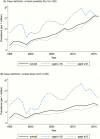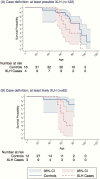Prevalence and Mortality of Individuals With X-Linked Hypophosphatemia: A United Kingdom Real-World Data Analysis - PubMed (original) (raw)
Prevalence and Mortality of Individuals With X-Linked Hypophosphatemia: A United Kingdom Real-World Data Analysis
Samuel Hawley et al. J Clin Endocrinol Metab. 2020.
Abstract
Background: X-linked hypophosphatemia (XLH) is a rare multisystemic disease with a prominent musculoskeletal phenotype. We aim here to improve understanding of the prevalence of XLH across the life course and of overall survival among people with XLH.
Methods: This was a population-based cohort study using a large primary care database in the United Kingdom (UK) from 1995 to 2016. XLH cases were matched by age, gender, and practice to up to 4 controls. Trends in prevalence over the study period were estimated (stratified by age) and survival among cases was compared with that of controls.
Findings: From 522 potential cases, 122 (23.4%) were scored as at least possible XLH, while 62 (11.9%) were classified as highly likely or likely (conservative definition). In main analyses, prevalence (95% CI) increased from 3.1 (1.5-6.7) per million in 1995-1999 to 14.0 (10.8-18.1) per million in 2012-2016. Corresponding estimates using the conservative definition were 3.0 (1.4-6.5) to 8.1 (5.8-11.4). Nine (7.4%) of the possible cases died during follow-up, at median age of 64 years. Fourteen (2.9%) of the controls died at median age of 72.5 years. Mortality was significantly increased in those with possible XLH compared with controls (hazard ratio [HR] 2.93; 95% CI, 1.24-6.91). Likewise, among those with likely or highly likely XLH (HR 6.65; 1.44-30.72).
Conclusions: We provide conservative estimates of the prevalence of XLH in children and adults within the UK. There was an unexpected increase in mortality in later life, which may have implications for other fibroblast growth factor 23-related disorders.
Keywords: XLH; hypophosphatemia; prevalence; rate; rickets; survival.
© Endocrine Society 2019.
Figures
Figure 1.
Prevalence of XLH by calendar year and age band for: (A) all possible cases of XLH and (B) only likely and highly likely cases of XLH.
Figure 2.
Kaplan-Meier plot for survival across lifespan for: (A) all possible cases of XLH and (B) only likely and highly likely cases of XLH.
Similar articles
- The Diagnostic Odyssey in Children and Adolescents With X-linked Hypophosphatemia: Population-Based, Case-Control Study.
Boardman-Pretty F, Clift AK, Mahon H, Sawoky N, Mughal MZ. Boardman-Pretty F, et al. J Clin Endocrinol Metab. 2024 Jul 12;109(8):2012-2018. doi: 10.1210/clinem/dgae069. J Clin Endocrinol Metab. 2024. PMID: 38335127 Free PMC article. - Higher prevalence of non-skeletal comorbidity related to X-linked hypophosphataemia: a UK parallel cohort study using CPRD.
Hawley S, Shaw NJ, Delmestri A, Prieto-Alhambra D, Cooper C, Pinedo-Villanueva R, Javaid MK. Hawley S, et al. Rheumatology (Oxford). 2021 Sep 1;60(9):4055-4062. doi: 10.1093/rheumatology/keaa859. Rheumatology (Oxford). 2021. PMID: 33331900 - Epidemiological analysis to identify predictors of X-linked hypophosphatemia (XLH) diagnosis in an Italian pediatric population: the EPIX project.
Crisafulli S, Ingrasciotta Y, Vitturi G, Fontana A, L'Abbate L, Alessi Y, Ferraù F, Cantarutti L, Lazzerini D, Cannavò S, Trifirò G. Crisafulli S, et al. Endocrine. 2024 Aug;85(2):894-905. doi: 10.1007/s12020-024-03793-5. Epub 2024 Apr 9. Endocrine. 2024. PMID: 38592637 Free PMC article. - Diagnosis, treatment-monitoring and follow-up of children and adolescents with X-linked hypophosphatemia (XLH).
Rothenbuhler A, Schnabel D, Högler W, Linglart A. Rothenbuhler A, et al. Metabolism. 2020 Feb;103S:153892. doi: 10.1016/j.metabol.2019.03.009. Epub 2019 Mar 27. Metabolism. 2020. PMID: 30928313 Review. - Burden of disease and clinical targets in adult patients with X-linked hypophosphatemia. A comprehensive review.
Giannini S, Bianchi ML, Rendina D, Massoletti P, Lazzerini D, Brandi ML. Giannini S, et al. Osteoporos Int. 2021 Oct;32(10):1937-1949. doi: 10.1007/s00198-021-05997-1. Epub 2021 May 19. Osteoporos Int. 2021. PMID: 34009447 Free PMC article. Review.
Cited by
- Longitudinal assessment of physical function in adults with X-linked hypophosphatemia following initiation of burosumab therapy.
Orlando G, Roy M, Bubbear J, Clarke S, Keen R, Javaid MK, Ireland A. Orlando G, et al. Osteoporos Int. 2024 Nov;35(11):2055-2060. doi: 10.1007/s00198-024-07095-4. Epub 2024 Jul 19. Osteoporos Int. 2024. PMID: 39028421 - Real-world non-interventional post-authorization safety study of long-term use of burosumab in children and adolescents with X-linked hypophosphatemia: first interim analysis.
M Boot A, Ariceta G, Beck-Nielsen SS, Brandi ML, Briot K, Collantes CL, Giannini S, Haffner D, Keen R, Levtchenko E, Mughal MZ, Makitie O, Nilsson O, Schnabel D, Tripto-Shkolnik L, Zillikens MC, Liu J, Tudor A, Emma F. M Boot A, et al. Ther Adv Chronic Dis. 2024 May 18;15:20406223241247643. doi: 10.1177/20406223241247643. eCollection 2024. Ther Adv Chronic Dis. 2024. PMID: 38764445 Free PMC article. - Experience of X-linked hypophosphatemic rickets in the Gulf Cooperation Council countries: case series.
Al-Juraibah F, Al Shaikh A, Al-Sagheir A, Babiker A, Al Nuaimi A, Al Enezi A, Mikhail GS, Mundi HA, Penninckx HK, Mustafa H, Al Ameri M, Al-Dubayee M, Ali NS, Fawzy N, Al Shammari S, Fiad T. Al-Juraibah F, et al. Endocrinol Diabetes Metab Case Rep. 2024 Apr 11;2024(2):23-0098. doi: 10.1530/EDM-23-0098. Print 2024 Apr 1. Endocrinol Diabetes Metab Case Rep. 2024. PMID: 38614130 Free PMC article. - The Diagnostic Odyssey in Children and Adolescents With X-linked Hypophosphatemia: Population-Based, Case-Control Study.
Boardman-Pretty F, Clift AK, Mahon H, Sawoky N, Mughal MZ. Boardman-Pretty F, et al. J Clin Endocrinol Metab. 2024 Jul 12;109(8):2012-2018. doi: 10.1210/clinem/dgae069. J Clin Endocrinol Metab. 2024. PMID: 38335127 Free PMC article. - Latin-American consensus on the transition into adult life of patients with X-linked hypophosphatemia.
Kastelic MS, Roman-González A, De Paula Colares Neto G, De Paula FJA, Reza-Albarrán AA, Morales LR, Tormo S, Meza-Martínez AI. Kastelic MS, et al. Endocrine. 2024 Apr;84(1):76-91. doi: 10.1007/s12020-023-03624-z. Epub 2023 Dec 20. Endocrine. 2024. PMID: 38117452 Free PMC article.
References
- A gene (PEX) with homologies to endopeptidases is mutated in patients with X-linked hypophosphatemic rickets. The HYP Consortium. Nat Genet. 1995;11(2):130–136. - PubMed
- ADHR Consortium. Autosomal dominant hypophosphataemic rickets is associated with mutations in FGF23. Nat Genet. 2000;26(3):345–8. - PubMed
- Cai Q, Hodgson SF, Kao PC, et al. Brief report: inhibition of renal phosphate transport by a tumor product in a patient with oncogenic osteomalacia. N Engl J Med. 1994;330(23):1645–1649. - PubMed
Publication types
MeSH terms
Grants and funding
- MC_U147585827/MRC_/Medical Research Council/United Kingdom
- DH_/Department of Health/United Kingdom
- MC_U147585819/MRC_/Medical Research Council/United Kingdom
- MC_UP_A620_1014/MRC_/Medical Research Council/United Kingdom
- MC_UU_12011/1/MRC_/Medical Research Council/United Kingdom
- G0400491/MRC_/Medical Research Council/United Kingdom
- MC_U147585824/MRC_/Medical Research Council/United Kingdom

